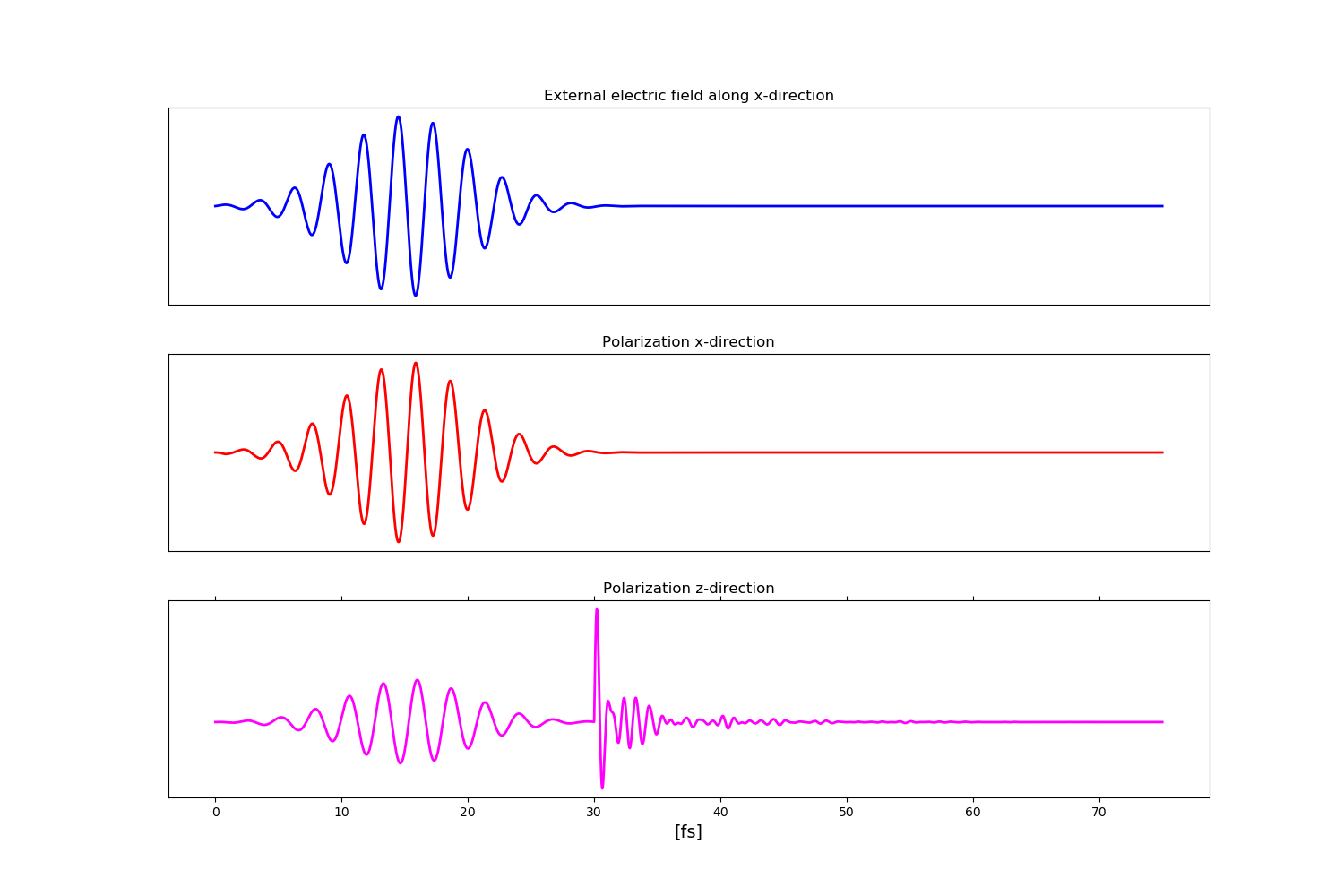Pump and Probe: Difference between revisions
No edit summary |
No edit summary |
||
| Line 9: | Line 9: | ||
We start from the bulk hBN with an in place lattice constant a=4.72431525 a.u. and c/a=2.6. Standard DFT input for hBN | We start from the bulk hBN with an in place lattice constant a=4.72431525 a.u. and c/a=2.6. Standard DFT input for hBN | ||
for ABINIT or QuantumEspresso can be found here [[Tutorials]]. We used 200 bands in the Non-self consistent calculation. | for ABINIT or QuantumEspresso can be found here [[Tutorials]]. We used 200 bands in the Non-self consistent calculation. | ||
In our example we choose direction [0,1,0] for the pump and the probe. We generate the ypp.in to remove symmetries with the command <span style="color:blue">ypp -y</span> and we modify it as: | In our example we choose direction [0,1,0] for the pump and the probe. We generate the ypp.in to remove symmetries with the command <span style="color:blue">ypp -y</span> and we modify it as: | ||
| Line 27: | Line 26: | ||
#RmSpaceInv # Remove Spatial Inversion | #RmSpaceInv # Remove Spatial Inversion | ||
then we go in the | then we go in the FixSymm directory and run again the setup. | ||
then we generate the Pump&Probe input with the command <span style="color:blue">yambo_nl -u p -V rt</span>: | then we generate the Pump&Probe input with the command <span style="color:blue">yambo_nl -u p -V rt</span>: | ||
Revision as of 14:35, 10 January 2022
This tutorial works only with Yambo version > 5.0, that will be released soon.
In this tutorial we will show you how to setup two external fields in yambo_nl, to perform pump and probe simulation.
The input simulation parameters of these tutorial require large computational power,
we advice you to run them in parallel, or to use simplified parameters for example less bands, k-points and so on.
This tutorial supposes that you are already familiar with real-time simulation with Yambo,
if it is not the case please check these tutorials: Tutorials#Non_linear_response
We start from the bulk hBN with an in place lattice constant a=4.72431525 a.u. and c/a=2.6. Standard DFT input for hBN for ABINIT or QuantumEspresso can be found here Tutorials. We used 200 bands in the Non-self consistent calculation.
In our example we choose direction [0,1,0] for the pump and the probe. We generate the ypp.in to remove symmetries with the command ypp -y and we modify it as:
fixsyms # [R] Remove symmetries not consistent with an external perturbation % Efield1 0.000000 | 1.000000 | 0.000000 | # First external Electric Field % % Efield2 0.000000 | 1.000000 | 0.000000 | # Additional external Electric Field % BField= 0.000000 T # [MAG] Magnetic field modulus Bpsi= 0.000000 deg # [MAG] Magnetic field psi angle [degree] Btheta= 0.000000 deg # [MAG] Magnetic field theta angle [degree] #RmAllSymm # Remove all symmetries RmTimeRev # Remove Time Reversal #RmSpaceInv # Remove Spatial Inversion
then we go in the FixSymm directory and run again the setup. then we generate the Pump&Probe input with the command yambo_nl -u p -V rt:
nloptics # [R] Non-linear spectroscopy DIP_Threads=0 # [OPENMP/X] Number of threads for dipoles NL_Threads=0 # [OPENMP/NL] Number of threads for nl-optics % NLBands 3 | 6 | # [NL] Bands range % NLverbosity= "high" # [NL] Verbosity level (low | high) NLstep= 0.010000 fs # [NL] Time step length NLtime= 75.0000 fs # [NL] Simulation Time NLintegrator= "INVINT" # [NL] Integrator ("EULEREXP/RK2/RK4/RK2EXP/HEUN/INVINT/CRANKNIC") NLCorrelation= "IPA" # [NL] Correlation ("IPA/HARTREE/TDDFT/LRC/LRW/JGM/SEX") NLLrcAlpha= 0.000000 # [NL] Long Range Correction NLDamping= 0.100000 eV # [NL] Damping (or dephasing) RADLifeTime= 15.00000 fs # [RT] Radiative life-time (if negative Yambo sets it equal to Phase_LifeTime in NL) #UseDipoles # [NL] Use Covariant Dipoles (just for test purpose) #FrSndOrd # [NL] Force second order in Covariant Dipoles #EvalCurrent # [NL] Evaluate the current HARRLvcs= 10417 RL # [HA] Hartree RL components EXXRLvcs= 10417 RL # [XX] Exchange RL components % ExtF_Dir 1.000000 | 1.000000 | 0.000000 | # [NL ExtF] Field Versor % % ExtF_Freq 1.500000 | 1.500000 | eV # [NL ExtF] Field Frequency % ExtF_Int= 1000.00 kWLm2 # [NL ExtF] Field Intensity ExtF_Width= 5.00000 fs # [NL ExtF] Field Width ExtF_kind= "QSSIN" # [NL ExtF] Kind(SIN|SOFTSIN|RES|ANTIRES|GAUSS|DELTA|QSSIN) ExtF_Tstart= 0.010000 fs # [NL ExtF] Initial Time % ExtF2_Dir 0.000000 | 0.000000 | 1.000000 | # [NL ExtF] Field Versor % % ExtF2_Freq 0.100000 | 0.100000 | eV # [NL ExtF] Field Frequency % ExtF2_Int= 10.0000 kWLm2 # [NL ExtF] Field Intensity ExtF2_Width= 0.000000 fs # [NL ExtF] Field Width ExtF2_kind= "DELTA" # [NL ExtF] Kind(SIN|SOFTSIN|RES|ANTIRES|GAUSS|DELTA|QSSIN) ExtF2_Tstart= 30.00000 fs # [NL ExtF] Initial Time
In this simulation we set a dephasing of 0.1 eV and a radiative life-time of 15 fs, The two external field are a sinus with frequency 1.5 eV convoluted with a Guassian of width 5 fs with and intensity of 1000 KW/cm-2, and then a delta function that starts at 30 fs with an intensity of 10 KW/cm-2. Below we plot the external electric field in the x direction and the polarization in x and z directions:
